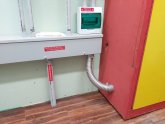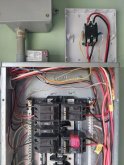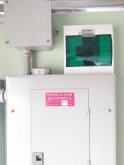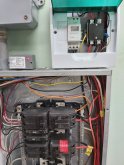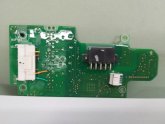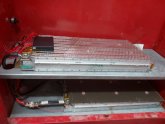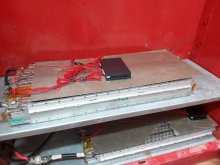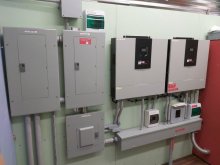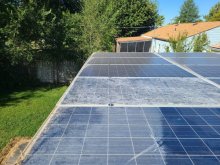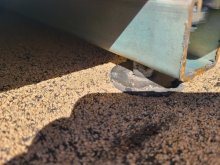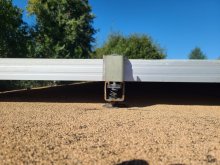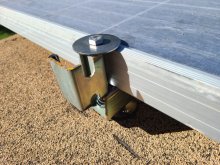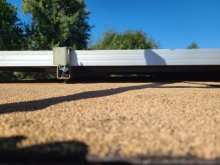SolarBro
Solar Budgeteer
- Joined
- Jun 27, 2020
- Messages
- 91
Thank you all for the help with some technical questions I had for this install. I thought Id pay it forward and show & tell this setup.
24x 300w 72-cell Poly panels 7.5 kw, 10KW soon.
LV 5048 Inverter
2x tesla modules
Unistrut DIY Pole-Barn type rack.
Misc. Equipment and such.
Total build cost was 7500$. I got a ton of deals and the bulk was building the rack myself.
I know I will get some hate for cutting costs using unistrut but its sturdy and im happy with how everything turned out.
Plus much of the material was free or recycled on craigslist and its better to save it from the landfill.
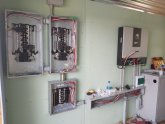
My Grid panel far left, Critical load center and my Dump load panel below it. All my DC breakers are in the white din rail box.

Covered all the panels up, have my dump load contactor mounted and a window AC unit (wills advice) in my power shed. Red box is a fire box to store the tesla modules. Fireboy Automatic fire unit on the wall. Still have little things to fix...

My two tesla modules. 300 AMP fused and 125 amp circuit breaker per inverter. No BMS, only charge to 48.2 volts and discharge to 44V. I wish there was a plug n play affordable BMS solution.
There is several youtubers running these for 2 years plus with no issues so long as they undercharge them. I put them in this fire rated nox just incase they go boom, i might be ok.
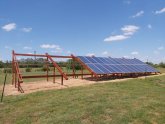
My DIY unistrut Rack. Build like a pole barn with poles set in concrete 4 ft down. Feels solid with lag bolted down unistrut. Temp fence to keep the cows out.
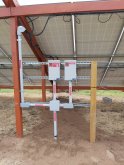
Behind the rack. Stainless clips and zips to keep the wire clean. Weatherhead entrance to 2x MNPN6s, has DIN rail mounted surge suppressors (not seen)
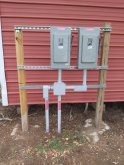
My DC disconnects from the outside of the shed incase of emergency. Upsized just incase I need high amperage down the road.
This was really fun to build and install. Ive never done solar before this but i have some electrical experience and along with youtube, i was able to do this. Engineer 775s vids about gutters was key in my install.
If you have any question, just let me know. Thank you all for the help!
SolarBro.
24x 300w 72-cell Poly panels 7.5 kw, 10KW soon.
LV 5048 Inverter
2x tesla modules
Unistrut DIY Pole-Barn type rack.
Misc. Equipment and such.
Total build cost was 7500$. I got a ton of deals and the bulk was building the rack myself.
I know I will get some hate for cutting costs using unistrut but its sturdy and im happy with how everything turned out.
Plus much of the material was free or recycled on craigslist and its better to save it from the landfill.

My Grid panel far left, Critical load center and my Dump load panel below it. All my DC breakers are in the white din rail box.

Covered all the panels up, have my dump load contactor mounted and a window AC unit (wills advice) in my power shed. Red box is a fire box to store the tesla modules. Fireboy Automatic fire unit on the wall. Still have little things to fix...

My two tesla modules. 300 AMP fused and 125 amp circuit breaker per inverter. No BMS, only charge to 48.2 volts and discharge to 44V. I wish there was a plug n play affordable BMS solution.
There is several youtubers running these for 2 years plus with no issues so long as they undercharge them. I put them in this fire rated nox just incase they go boom, i might be ok.

My DIY unistrut Rack. Build like a pole barn with poles set in concrete 4 ft down. Feels solid with lag bolted down unistrut. Temp fence to keep the cows out.

Behind the rack. Stainless clips and zips to keep the wire clean. Weatherhead entrance to 2x MNPN6s, has DIN rail mounted surge suppressors (not seen)

My DC disconnects from the outside of the shed incase of emergency. Upsized just incase I need high amperage down the road.
This was really fun to build and install. Ive never done solar before this but i have some electrical experience and along with youtube, i was able to do this. Engineer 775s vids about gutters was key in my install.
If you have any question, just let me know. Thank you all for the help!
SolarBro.
Last edited:



